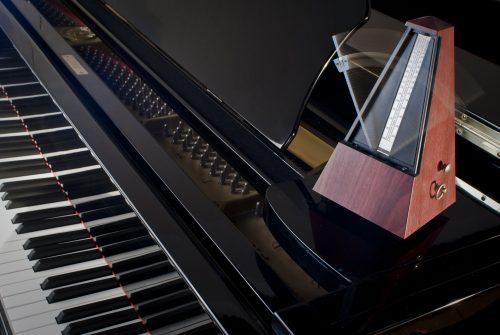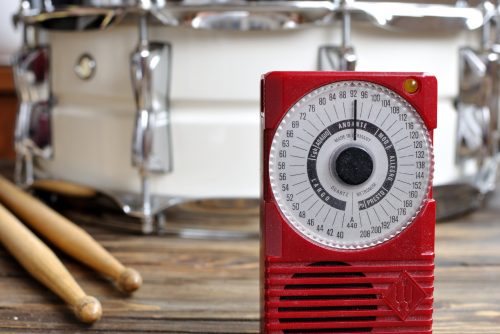The Metronome: Getting Started
June 22, 2020Written by Kyle Peters, percussion instructor
A metronome is an important tool that all musicians should use in their practice sessions. What might seem like a frustrating click or beep at first, will soon become one of the most beneficial tools to help you in your learning process. The metronome will not only improve your sense of time, but also allow for a more organized and structured practice session.
How to Begin:
Start with counting rhythm away from your instrument. Start simple, and slowly increase the level of difficulty in your counting exercises. Revisit old method books and use the rhythm of the melodies or exercises for counting examples.
Below is a simple rhythm exercise to get you started with the metronome. Begin at quarter note = 80. Count each exercise at three different tempos. Example: 80, 120, 60.
This exercise can be done as a warm up, walking to class, or during a commercial break. It can be difficult at first to tell if you are with the metronome. With guidance from your teacher and mindful practice you will be successful.
Once you are comfortable counting along with your metronome, it is time to add the instrument. Although the instrument is in our hands, counting is still key! Most musicians cannot verbally count and play/sing at the same time, but you are responsible to keep counting and subdivision in your head when playing.
Tips:
- Before playing anything with a metronome, allow yourself to listen to 5 to 10 clicks of your tempo. This will allow you to internalize the time. A problem I see when starting with a metronome is not allowing yourself time to hear the tempo.
- Always start slow. Just because a piece is marked at 120 does not mean you start there. Start at 60, and work your way up. Starting slow with a metronome will help prevent any bad habits from forming. I always tell my students “Accuracy over speed.”
- Make sure you can hear the metronome when you play. This might seem obvious but instruments can be loud! It is important you always hear the metronome clearly.
- Start with one measure at a time. I tell my students “playing with a metronome is not hard, it is just new.” With all new technique, we want to start slow or in smaller chunks. Count one measure at a time and see if you are still with the click. If not, find out where in the measure you rushed or slowed down. Repeat multiple times until you can consistently stay with the click.
- Take breaks. I have seen many musicians get frustrated with the metronome. When working on a new skill start with just 5 minutes at a time. If you find yourself getting frustrated, stop and take a break. Frustration will only lead to more mistakes and a lack of focus.
- Slow Tempos: If you are working on a piece that is a slower tempo, it might help to have the metronome on a smaller subdivision. For example, if something you are working on is marked at Quarter Note = 50, put the metronome on 100. This will give you the eighth note subdivision. As you become more comfortable with the metronome, and develop a stronger sense of time, you will then be able play along with a slower click.
Tendencies:
As you practice with a metronome, keep track of your tendencies of time. Some of the most common examples I observe are:
- Longer Note Lengths: Are you holding your long notes for the correct value? When I first started with a metronome I realized I cut all of my long notes short!
- Rest Values: When listening to juries, solofest, and auditions, the number one issue with tempo is rest lengths. Rests are often cut short or even overlooked. It is important to count through all rests. Although we do not play/sing during rests they still have a rhythmic value. The metronome will allow you to fill that space with clicks to keep our tempo steady.
- Technical Passages: When you reach a very challenging point in your solo, do you maintain a steady tempo? When practicing a piece of music you should only play as fast as your most difficult measure. Make sure the metronome click allows you to develop a fluid tempo in and out of technical passages.
What are your tendencies you notice when practicing with a metronome? The metronome will allow you to identify and fix these aspects of your playing.
How often should I use a metronome?
Always. I recommend using your metronome for at least 90% of your practice session. I always have mine on my music stand. When learning a new piece of music, start of with a metronome. Once you are use to practicing with a metronome, and know your tendencies you will start learning music more efficiently.
Advanced Metronome Practice:
Once you feel very comfortable playing with a metronome, try some of these techniques in your daily practice:
- Off Beat Clicks: Have the metronome click on the off beats. When changing where the pulse lands you might discover different tendencies in your playing. Try this for the example above.
- Downbeat Clicks: Have the metronome only click on the downbeat of each measure. This will challenge your consistency of time! If this is too difficult at first, start with every two beats and work your way to a full measure. You can extend this even further. Example – a click on every other measure.
Moving around where the click falls in your music will strengthen your internal pulse. It can be applied to a piece you know very well to challenge your time keeping skills at a high level.

Conclusion:
The metronome is a great tool to track your progress. Starting a piece with the click at 50 and progressing to 100 is a great feeling. It allows you to be more attentive to details and correct problems you might not know are happening with out one! Remember – do not increase the speed until you are playing accurately at your current tempo.
Enjoy the process of using a metronome! It will take time to get used to, but it is a useful skill to acquire. If this is new for you, take your time – playing with a metronome is not hard, it is just new! In time you will improve your internal pulse, strengthening all other aspects of your playing.


